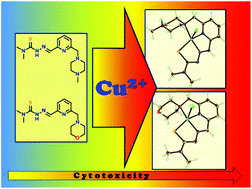Strong effect of copper(ii) coordination on antiproliferative activity of thiosemicarbazone–piperazine and thiosemicarbazone–morpholine hybrids†
Abstract
In this study, 2-formylpyridine thiosemicarbazones and three different heterocyclic pharmacophores were combined to prepare thiosemicarbazone–piperazine mPip-FTSC (HL1) and mPip-dm-FTSC (HL2), thiosemicarbazone–morpholine Morph-FTSC (HL3) and Morph-dm-FTSC (HL4), thiosemicarbazone–methylpyrrole-2-carboxylate hybrids mPyrr-FTSC (HL5) and mPyrr-dm-FTSC (HL6) as well as their copper(II) complexes [CuCl(mPipH-FTSC-H)]Cl (1 + H)Cl, [CuCl(mPipH-dm-FTSC-H)]Cl (2 + H)Cl, [CuCl(Morph-FTSC-H)] (3), [CuCl(Morph-dm-FTSC-H)] (4), [CuCl(mPyrr-FTSC-H)(H2O)] (5) and [CuCl(mPyrr-dm-FTSC-H)(H2O)] (6). The substances were characterized by elemental analysis, one- and two-dimensional NMR spectroscopy (HL1–HL6), ESI mass spectrometry, IR and UV–vis spectroscopy and single crystal X-ray diffraction (1–5). All compounds were prepared in an effort to generate potential antitumor agents with an improved therapeutic index. In addition, the effect of structural alterations with organic hybrids on aqueous solubility and copper(II) coordination ability was investigated. Complexation of ligands HL2 and HL4 with copper(II) was studied in aqueous solution by pH-potentiometry, UV–vis spectrophotometry and EPR spectroscopy. Proton dissociation processes of HL2 and HL4 were also characterized in detail and microscopic constants for the Z/E isomers were determined. While the hybrids HL5, HL6 and their copper(II) complexes 5 and 6 proved to be insoluble in aqueous solution, precluding antiproliferative activity studies, the thiosemicarbazone–piperazine and thiosemicarbazone–morpholine hybrids HL1–HL4, as well as copper(II) complexes 1–4 were soluble in water enabling cytotoxicity assays. Interestingly, the metal-free hybrids showed very low or even a lack of cytotoxicity (IC50 values > 300 μM) in two human cancer cell lines HeLa (cervical carcinoma) and A549 (alveolar basal adenocarcinoma), whereas their copper(II) complexes were cytotoxic showing IC50 values from 25.5 to 65.1 μM and 42.8 to 208.0 μM, respectively in the same human cancer cell lines after 48 h of incubation. However, the most sensitive for HL4 and complexes 1–4 proved to be the human cancer cell line LS174 (colon carcinoma) as indicated by the calculated IC50 values varying from 13.1 to 17.5 μM.


 Please wait while we load your content...
Please wait while we load your content...